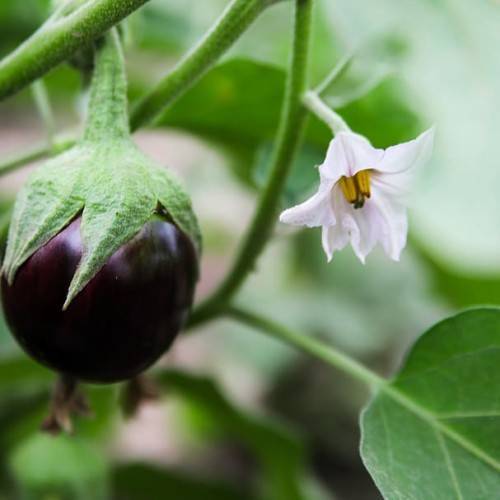
eggplant
Solanum melongena 'Aswad'
Cycle:
Herbaceous Perennial
Watering:
Average
Hardiness Zone:
9 - 12
Flowers:
Flowers In Spring
Sun:
full sun
Fruits:
Fruits Ready In Summer
Edible:
Yes
Leaf:
Yes
Growth Rate:
High
Maintenance:
Moderate
Drought Tolerant:
Yes
Salt Tolerant:
Yes
Care Level:
Medium
watering
Eggplant (Solanum melongena 'Aswad') should be watered once a week, approximately 1 to 1.5 inches of water per week. Water thoroughly, allowing the soil to become evenly moist, but not soaked. In dry weather, it may be necessary to water more often during the growing season. Avoid overhead watering, as foliage may become susceptible to fungal diseases. It is important to check soil for moisture before watering and to develop a regular watering schedule for your plants.
sunlight
Eggplant (Solanum Melongena 'Aswad') requires 6 to 8 hours of direct sunlight every day in order to thrive and produce healthy fruits. Recommended sunlight exposure for this plant species is 10 to 12 hours per day; however, it has been observed that a slightly lower amount can be beneficial under certain conditions. The best time of day for providing Eggplant with sunlight should be morning and afternoon, rather than at midday. Make sure to avoid exposing your Eggplant to more than 12 hours of direct sunlight, as this could cause sunburn or wilted leaves.
pruning
Eggplant (Solanum melongena 'Aswad') should be pruned regularly throughout the growing season. Pruning is important because it stimulates vegetative growth, encourages young and productive shoots, and prevents overcrowding. When to Prune: Pruning of eggplant should start when the plant is about 15cm tall and continue throughout the growing season. To encourage strong vegetative growth and productive shoots, prune the main stem back to 10-15 cm when it reaches about 20-25 cm. Remove any shoots at the same time that have failed to develop properly. After the first pruning, check the plant each week for any new lateral shoots or suckers that need to be removed - cutting them back to 2-3 buds. In late summer, about 2 months before the first frost, remove all lateral shoots up to the second to last bud. How Much to Prune: Eggplant should be pruned so that no more than 2 laterals are left per node and the main stem and branches should be shaped with an even canopy. Also, remove any unproductive or weak shoots that may be crowding the canopy. As a general guide, remove no more than a third of the plant’s leaves and shoots at 1 time, and avoid pruning during hot, dry weather.
Propagation
Season
Hardiness Map
FAQ
Are eggplant and aubergines the same plant?
Yes, Eggplant and Aubergines are the same plant. They are both members of the Solanum melongena family, native to India and now cultivated worldwide. The two different names are primarily a result of different regional English dialects and the French name used in other parts of the world. Eggplants can also be known as brinjals in some parts of the world. Regardless of the name, they are the same plant.
Do aubergines contain fiber?
Yes, aubergines (eggplants) contain a good amount of fibre. 100 grams of aubergine provides 2.6 grams of fibre, which is 10% of the recommended daily allowance (RDA). Fiber is an important part of any healthy diet as it helps with digestion, keeps you full longer, lowers cholesterol, and even helps to regulate blood sugar levels and may reduce the risk of some diseases.
Do aubergines need a lot of space to grow?
Yes, like many other vegetables, aubergines need plenty of space to grow. They should be planted at least 18-24 inches apart from each other to allow enough room for them to expand. Additionally, they need enough space for proper airflow to ensure that the plants remain healthy and free of disease. Growers may wish to grow more than one aubergine plant in one area, but it’s important to space them out properly for best results.
Can we eat aubergines leaves?
Yes, aubergine leaves are edible and can be eaten. The leaves are high in antioxidants, which can protect cells in the body from damage. They are also a good source of dietary fiber, which can help keep the digestive system healthy. They should be cooked before being eaten, as when eaten raw they can cause stomach irritation. When cooked, the leaves can be added to salads, soups, pasta dishes and stir-fries for extra flavor and texture.
Is crop rotation necessary for aubergines plants cultivated?
Yes, crop rotation is necessary for aubergines plants cultivated. This is because rotating crops in the same soil helps reduce soil-borne disease, reduce weed growth, conserve soil nutrients, and improve soil structure. In addition, rotating aubergines with other crops prevents the build-up of diseases and pests in the soil, as they will not be able to survive over the long term on just one crop. Finally, when aubergines are rotated with other crops it allows the soil to rest and recharge, preserving soil fertility and improving crop yields in the long run.
Can aubergine plant flowers be edible?
The short answer is yes. Depending on the variety of aubergine, the flower can be edible. It is typically a light purple or white color and should be picked when it is young and unopened. The flower petals can be cooked in a variety of dishes or eaten raw. The flavor is somewhat bitter and sweet, but the texture is similar to a squash flower. When selecting edible flowers, always make sure they are not sprayed with any chemicals or pesticides.
Can you grow aubergines indoors all around the year?
No, it is not possible to grow aubergines indoors all around the year. Aubergines, also known as eggplants, are warm-weather crops and require temperatures of at least 70°F (21°C) for successful growth. Unless you can create a consistently warm environment indoors that is also well-lit, aubergines will not thrive. In colder climates, a greenhouse may be the best place for successful eggplant growing.
